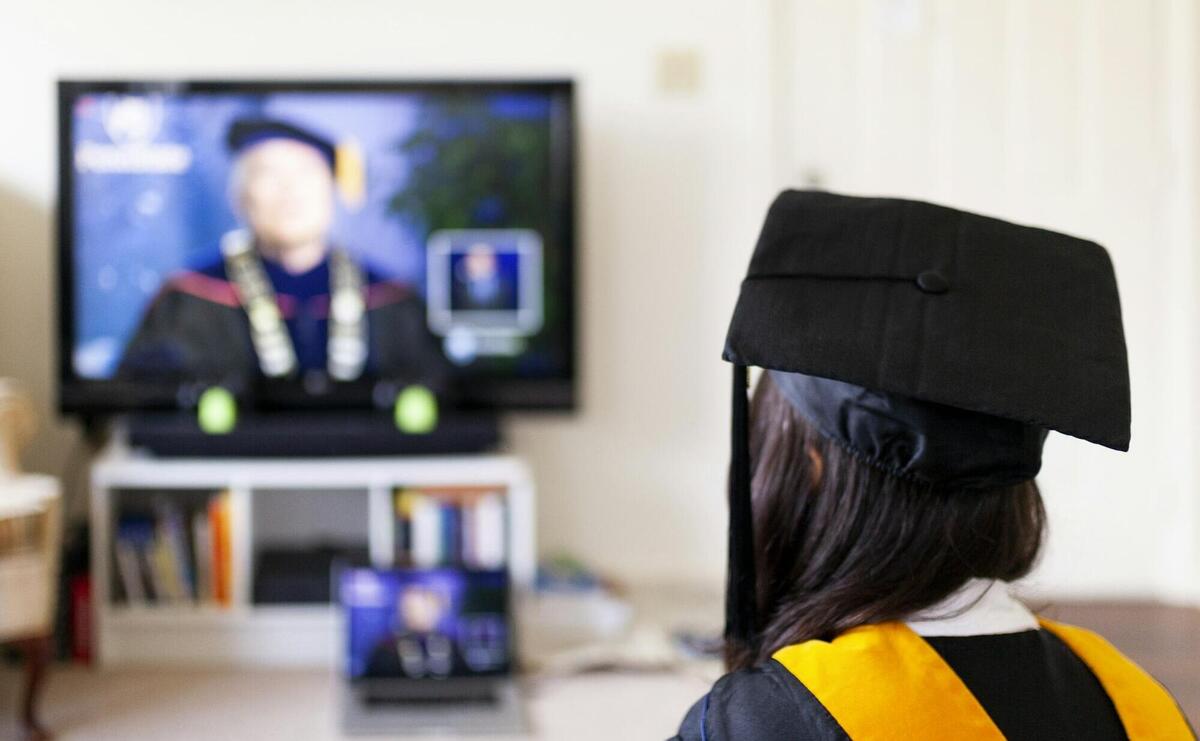Virtual Learning Guide: Definition, Examples & Benefits

Although virtual learning is a broader term, it is typically connected to online courses and settings. Whether you're teaching virtually or taking online classes, it is important to have a solid understanding of virtual learning and how it works.
After all, many educational institutions now offer online programs for their students, and understanding how to benefit from them might benefit your academic success and career moving forward.
This post will define virtual learning, its characteristics, benefits, and how it compares to teaching in a physical classroom.
Short Summary
- Virtual learning, online learning, remote learning, e-learning, and distance learning are different types of online learning.
- Virtual learning delivers online education to students in virtual classrooms.
- The virtual learning environment provides more flexibility and variety and is more affordable than the traditional one.
What Is Virtual Learning?
Online learning aims to provide an online alternative to the traditional classroom. Virtual learning aims to replicate the structure, resources, and activities of classroom-based teaching but also adds new elements, such as various tools.
Virtual learning also aims to improve areas for improvement of the traditional model by using computers and/or the Internet, both within and outside of the educational institution's buildings.
The majority of the time, the lessons are held online. In virtual learning, the teacher and students are physically apart, whether through time or location.
A virtual learning environment is one in which teachers use audio or video to teach their students through a digital curriculum.
Virtual Learning Types

There are three possible learning environments for online learning: asynchronous (self-paced), synchronous (real-time), and hybrid.
Each of these types works well for certain online education formats, and it will depend on your education goals, preferences, and needs to decide which virtual learning type is right for you.
Also, some educational institutions offer only one virtual learning type, so you cannot choose between several options. Make sure you research all your options well before enrolling in any program.
Synchronous Learning Process
Students who start learning in synchronous virtual learning programs watch their lectures live online. For a more interactive learning environment, the teacher allows online students to ask questions in real-time via camera, microphone, or live chat during their presentation or lecture. Synchronous online courses provide students with consistent structure and pace of instruction.
Asynchronous Learning Process
Asynchronous virtual learning refers to online students attending lectures that have been pre-recorded and can be watched when it's more convenient for them. Quizzes on the subject are quite common to ensure students pay attention to teachers and follow the timetable. Teachers in asynchronous online programs are typically available via chat or email.
Hybrid Learning Process
Both online and in-person learning will be included in the hybrid learning model. This is the most typical online course model suitable for lessons requiring a lab component. Starting a hybrid course might be a good option if you want the flexibility to study whenever it's most convenient for you but still want some planned sessions and access to your online teacher.
Main Characteristics of Online Learning

Undoubtedly, a virtual learning environment will differ quite from a traditional one. However, several requirements must be met when discussing successful virtual learning models.
These online learning characteristics are essential for creating a virtual classroom that provides a great learning experience:
- Video conferencing software: Teachers must have a platform to interact with their students. Communication is key to educational success, so video platforms allow teachers to set up a quality learning environment.
- User-friendly experience: A virtual learning environment should fit each student's abilities. What works for one might not work well for other students, so the learning process should be personalized.
- Participation control: Teachers should be able to mute and unmute their students to improve the quality of interaction for the entire group.
- Instant messaging: Online learners should be able to interact with themselves and their teachers through multiple platforms, and interactive tools that enable quick communication are highly recommended.
- Digital whiteboard: Teachers should have an online whiteboard for explanations and demonstrations and to boost engagement throughout the online course.
- Assessment tools: Keeping track of students' progress is simplified by using different tools that show teachers the unique learning experiences of each student.
- Video recording software: Recording virtual lessons enables teachers to use it for future reference and give students access to the learning material if they haven't attended the lecture.
Virtual Learning Environment Vs. Traditional Learning Environment

Virtual learning, online learning, e-learning, and remote learning refer to distance learning requiring the Internet to connect teachers with their students.
On the other hand, a traditional learning environment happens in a classroom where a teacher teaches students a specific lesson.
Not only does traditional learning have a fixed place to deliver lessons, but it also takes place in a specific location. Students must attend classes in a specific school, college, university, or other educational institution.
Virtual learning teachers deliver lessons through different multimedia forms (text, images, videos, etc.), while students must complete any online assessment.
Compared to a classroom-based environment, online learning has more limited interaction between teachers and students, but numerous benefits make up for it.
Both options will give you quality education, degree or certification the program offers, and guidance throughout the course.
Advantages of Virtual Learning
There are benefits and drawbacks to virtual learning and in a virtual classroom, just like traditional learning environments.
Virtual learning has many advantages, such as more flexibility in your schedule, saving money compared to traditional degree options, and the convenience of working while studying.
Remember that none of the advantages mentioned in this article should be more important than your preferences. Some students might look for a more traditional approach or see it as an opportunity to make friends, so virtual learning might not be the best option.
However, virtual learning has far more advantages than disadvantages, especially for those who pursue education while working or fulfilling family responsibilities.
Participating in classes from the comfort of your home will save you time, money, and energy.
Here are some of the most notable benefits of remote learning:
- Flexibility
- Lower costs
- Course variety
- Career advancement opportunities
- Personalized approach
- Immediate feedback
- Collaborative learning opportunities
- Consistent access to course materials
- More free time
Best Virtual Learning Platforms And Software Solutions
Several virtual resources and technologies are utilized to streamline the learning process and enhance communication between students and teachers to create a successful virtual learning environment.
Features like a digital whiteboard, file sharing, instant messaging, live video conferences, discussion boards, and third-party integration should all be included in this program.
Whether you're an online teacher or a student, you will need to familiarize yourself with some of these platforms used in most online educational institutions to be able to have a positive virtual learning experience:
- Zoom
- Google Classroom
- Learn Cube
- ClassIn
- Adobe Connect
- BigBlueButton
- Canva
- ClassDojo
- Peer Deck
- Kahoot
That said, a virtual learning program will also use a learning content management system to make the learning materials available to students. There is a variety of such content management systems available, and both students and teachers will need to learn how to use them to achieve success.
Requirements to Take Online Courses

As a student, you will want to ensure your virtual learning experience is successful and enjoyable for you. Regardless of participating in a distance learning program with synchronous classes, asynchronous courses, or blended learning, you will need to meet a few requirements to be able to stay on course.
The first and most important requirement is a good and stable Internet connection. As much as you will be listening more than talking, you need an Internet connection to keep up with the video conferencing software that your virtual classroom uses.
Unlike in-person classes, you will attend them from home, so it's necessary to ensure all requirements are met for consistent student interactions with the class.
Another requirement is having a computer. Luckily, most students today have computers and Internet access at home.
If your computer has no microphone integrated, you must buy one. The same goes for the webcam, as all virtual classrooms are student-centered, so your teacher will need to be able to see you and hear you.
Tips for Entering a Virtual Classroom
You might feel unprepared or overwhelmed as a student attending an online class for the first time. However, there are certain things you can do to improve your own learning experience and achieve success with the online course.
Firstly, it's recommended to learn to use all virtual learning tools the virtual classroom will use throughout the course. This will save time and energy but also help you learn faster.
Secondly, you should go through your learning materials to get an idea about how many hours you will need to allocate for studying which part. After all, virtual classrooms require you to prepare and stick to your study plan, even if you attend virtual classes at your own pace.
Thirdly, you must understand the importance and challenges of staying engaged in online teaching environments. Eliminate all distractions to successful student learning in your physical space, ensure a good Internet connection, and ask questions about the learning content.
Lastly, take care of yourself. If you work, make sure your working hours do not overlap with your virtual classes. Educational experiences require organization and dedication but also time to recharge your batteries. Maximize the potential of online resources such as Google or Outlook calendar to plan your days and to be on track with all your online learning activities.
Here are simple tricks that work for students who are enrolling in virtual learning programs for the first time:
- Manage your time wisely
- Ask for help when needed
- Learn how you study best
- Stay motivated
- Reward yourself
- Actively participate in class
- Interact with classmates
Downsides of Virtual Learning
We've shared all the benefits virtual classrooms offer students and how virtual learning tools simplify learning. However, you must be aware of certain disadvantages of virtual learning.
Students and teachers in an online environment have different dynamics than those in a traditional setting.
Virtual learning environments are typically more affordable than traditional educational programs, but you must invest more than you would with in-person classes. Another downside of virtual learning courses is that they tend to experience technical issues, whether from the teacher's or student's side.
For instance, if you don't have an Internet connection, you will not be able to access video conferencing and depend on the learning materials handed to you afterward.
You will move less physically in a virtual learning environment than in a traditional classroom. With distance learning, students don't leave their homes to attend classes and are not motivated to get up, stretch their legs, and talk to their classmates during breaks.
We've mentioned that in virtual learning, you can access recorded classes and lecture notes at all times, but this also impacts students' level of active learning.
In a classroom-based education, students interact more with each other and their teachers, so their engagement will be higher than in virtual classrooms.
Also, it's important to mention isolation, which might lead to reduced social skills. If students are attending virtual learning classes, they will communicate less with each other. So, these critical factors should be addressed when deciding between an online learning program and a classroom-based program.
Conclusion

You should be aware that various factors can affect the virtual learning environment and your final online learning success. Don't forget to include your priorities and preferences when deciding to join a virtual learning program.
Keep in mind that all educational opportunities are unique, so you might want to look into discussion forums for reviews and get your questions answered before enrolling. After all, virtual learning is a way of the future, with more e-learning opportunities than traditional ones.
Frequently Asked Questions
What Is an Example of Virtual Learning?
Virtual learning uses different technological solutions to deliver online education to students. Such an online environment is structured similarly to traditional learning, but it offers more flexibility and is often more affordable. For teachers, online teaching also provides numerous benefits and innovative ways to interact with their students.
What Is Virtual Vs E-learning?
Both virtual learning and e-learning are forms of online learning, and they differ mostly in the level of communication and engagement between the teacher and students. E-learning examples are online courses, webinars, video lectures, and other online learning material. Virtual learning is a more interactive environment, placed in virtual classrooms and establishing a relationship between teachers and students.
What Is a Virtual Classroom?
A virtual classroom is an online alternative to traditional classrooms. Virtual classrooms provide online teaching for students who decide to enroll in these programs, from elementary to higher education. With virtual learning, teachers and students use digital devices for learning content and achieving success.
What Types of Virtual Learning Exist?
There are three types of virtual learning: synchronous, asynchronous, and hybrid courses. Synchronous classes require students to watch their lessons in real-time, while asynchronous online courses provide more flexibility, and students can choose when to watch. Hybrid classes are a result of these two types combined, and they bring the benefits of both into one model.